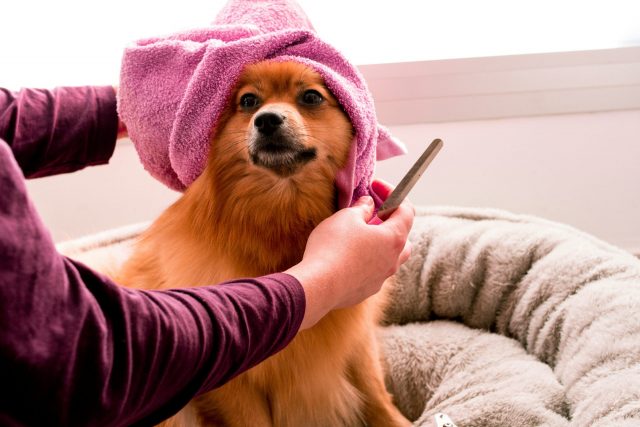Bathing your dog is an essential aspect of pet care that promotes cleanliness and overall health. However, many dog owners frequently find themselves pondering, “How often should you bathe your dog?” The answer to this question can vary significantly depending on several factors, including your dog’s breed, activity level, and any underlying health conditions. Regular bathing helps remove dirt, allergens, and loose fur, contributing to a healthier coat and skin. It can also be a bonding experience that strengthens the relationship between you and your furry friend.
This article will explore the various factors that influence how often you should bathe your dog and provide guidelines and tips to ensure your dog remains clean and healthy.

Factors Influencing Bath Frequency
Dog’s Breed and Coat Type
One of the primary factors determining how often you should bathe your dog is its breed and coat type. Dogs with short hair, such as Beagles and Boxers, typically require less frequent baths compared to long-haired breeds like Shih Tzus and Golden Retrievers. Short-haired dogs have less surface area for dirt and debris to accumulate, making them easier to keep clean with less frequent bathing. On the other hand, long-haired dogs are more prone to matting and tangling, which can trap dirt and cause skin issues if not managed with regular bathing and grooming.
Find Out The Top 11 Dog Breeds That Require Regular Bathing
Dog’s Activity Level
A dog’s activity level is another crucial factor in deciding how often to bathe them. Active dogs that spend a lot of time outdoors, running, playing, or swimming, will naturally get dirtier faster and may require more frequent baths. Conversely, dogs with a more sedentary lifestyle, such as older dogs or those with limited mobility, may stay cleaner longer and thus need fewer baths. Keeping a close eye on your dog’s activity and cleanliness can help you determine the appropriate bathing frequency.
Health Conditions and Allergies
Certain health conditions and allergies can also impact how often you should bathe your dog. Dogs with skin conditions like dermatitis or allergies may require more frequent baths with specialized shampoos to help manage symptoms and keep their skin healthy. In these cases, it’s essential to follow your veterinarian’s recommendations regarding bathing frequency and product use to ensure you are not exacerbating any underlying issues.
General Guidelines for Bathing Different Breeds
Short-Haired Breeds
Short-haired breeds, such as Dachshunds and Pit Bulls, typically require baths once every 8 to 12 weeks. Their coats are less prone to trapping dirt and debris, making them easier to maintain with less frequent bathing. Regular brushing can help remove loose fur and keep their coats looking clean between baths.
Long-Haired Breeds
Long-haired breeds like Yorkies and Afghan Hounds need more frequent baths, generally every 4 to 6 weeks. Their longer coats can easily trap dirt, debris, and allergens, making regular grooming and bathing essential to prevent matting and skin issues. Additionally, frequent brushing can help keep their coats healthy and reduce the need for baths.
Double-Coated Breeds
Double-coated breeds, such as Huskies and German Shepherds, have a unique grooming requirement. These dogs typically need baths every 6 to 8 weeks. Their dense undercoats can trap dirt and debris, and regular bathing helps keep their coats healthy and reduces shedding. It’s important to use the appropriate grooming tools to maintain their double coats and avoid damaging the undercoat during baths.
Signs Your Dog Needs a Bath
Odor
One of the most apparent signs that your dog needs a bath is a noticeable odor. If your dog starts to smell even after regular grooming, it may be time for a bath. A persistent bad smell can indicate that oils, dirt, and bacteria have accumulated on your dog’s skin and coat.
Dirt and Debris
Visible dirt and debris on your dog’s coat are clear indicators that it’s time for a bath. Dogs that spend a lot of time outdoors or in dusty environments are more likely to get dirty and need more frequent baths to keep their coats clean.
Skin Irritation
If your dog is scratching excessively or has visible signs of skin irritation, such as redness or flakiness, a bath might help soothe their skin. Using a gentle, dog-friendly shampoo can help alleviate discomfort and remove potential allergens causing the irritation.
Learn Which Dog Breeds Require The Least Grooming
Tips for Bathing Your Dog
Choosing the Right Shampoo
Selecting the right shampoo is crucial for maintaining your dog’s skin and coat health. Always choose a dog-friendly shampoo that is free from harsh chemicals and designed for your dog’s specific coat type and skin condition. Avoid using human shampoos, as they can be too harsh for your dog’s sensitive skin.
Proper Bathing Technique
To bathe your dog properly, start by brushing out any tangles or mats. Wet your dog thoroughly with lukewarm water, then apply the shampoo, working it into a lather from the neck down. Be sure to avoid getting shampoo in your dog’s eyes, ears, and nose. Rinse thoroughly to remove all traces of shampoo, as residue can irritate the skin.
Post-Bath Care
After bathing, dry your dog thoroughly with a towel or a blow dryer in a low, cool setting. Make sure your dog is completely dry to prevent any skin issues caused by moisture. Brush your dog’s coat to remove any tangles and keep it looking healthy and shiny.
Is Your Dog Suffering From Bad Baths? Discover The Signs
Final Thoughts on How Often You Should Bathe Your Dog
Determining how often you should bathe your dog depends on various factors, including breed, activity level, and health conditions. By understanding these factors and following the guidelines provided, you can ensure your dog remains clean and healthy. Regular baths, combined with proper grooming, play a crucial role in maintaining your dog’s overall hygiene and well-being. Remember, each dog is unique, so it’s essential to tailor your bathing routine to meet your dog’s specific needs.

 Toledo, United States.
Toledo, United States.